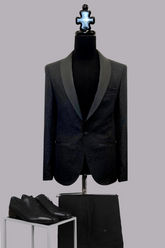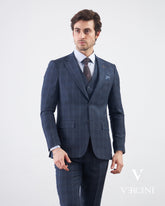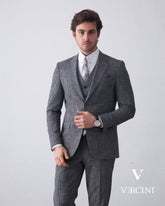A Comprehensive Guide to Men's Suits and Styles
The Evolution and Significance of Men's Suits
From the courtrooms of ancient civilizations to the bustling boardrooms of modern skyscrapers, men's suits have remained a consistent symbol of prestige, professionalism, and style. The mere image of a well-fitted suit evokes feelings of trust, authority, and elegance. But how did this iconic garment come to represent such profound significance?
Suits, as we know them, have origins in the European Renaissance. As society shifted away from flamboyant wardrobes, there emerged a preference for sleeker, more refined attire. This was a reflection of the changing societal norms which started valuing restraint, sophistication, and a departure from the extravagance of medieval times.
The Industrial Revolution further revolutionized the men's suit. With the onset of the corporate era, there was a greater need for standardized, formal clothing that would be appropriate for business settings. Thus, the suit became synonymous with business attire.
However, a suit is more than just fabric stitched together. It is an art form. The intricacies lie in the details: the fabric chosen, the way it's cut, the lapel style, the buttoning, and even the venting. Each decision made in the construction of a suit tells a story about its intended purpose, the occasion it's meant for, and the person wearing it.
But why have suits survived the test of time? Part of the reason lies in their versatility. They can be dressed up or down, suitable for both formal occasions and more casual settings. Moreover, they have a unique capability to instill confidence in the wearer. Slipping into a suit often feels like putting on a layer of armor, preparing the individual for the challenges of the day, be it a business negotiation, a romantic date, or a social gathering.
In modern times, the suit has seen even more variations. Different cultures, climates, and personal preferences have given birth to numerous styles and fits. From the sharp slim fits favored by urban professionals to the relaxed linen suits of tropical climes, there's a suit for every man and every occasion.
As we delve deeper into the details of various suit styles in the article below, remember that a suit, at its core, is about expressing oneself. It's a reflection of personal style, attitude, and the image one wants to portray to the world.
Men’s suits have been a staple in the male wardrobe for centuries, symbolizing professionalism, elegance, and style. Throughout time, they've evolved in terms of fit, buttoning, fabrics, and even the occasions they're appropriate for. Here's a guide to help you navigate the world of men's suits.
1. Suit Styles by Fit:
-
Regular (Classic) Fit: This traditional silhouette gives ample room in the chest and body, providing a comfortable fit for most body types.
-
Slim Fit: A contemporary design, it is more tapered at the waist and chest and is narrow through the arms and legs, best for slender profiles.
-
Modern (Tailored) Fit: Striking a balance between the classic and slim fit, the modern fit offers a semi-fitted appearance that's flattering for many.
-
Athletic Fit: Tailored for men with broad shoulders and a narrow waist, it’s a perfect fit for those with muscular builds.
2. Suit Styles by Buttoning:
-
Single Breasted: With just one column of buttons, it’s versatile enough for any occasion and can come in one, two, or three-button styles.
-
Double Breasted: Identified by two columns of buttons, this style leans towards the formal end and offers a regal appearance.
3. Suit Styles by Occasion:
-
Business Suit: Ideal for corporate settings, these are typically solid or with understated patterns.
-
Tuxedo (Dinner Suit): The go-to for black-tie events, characterized by satin lapels and side stripes on the pants.
-
Morning Suit: Preferred for formal daytime events, it includes a morning coat, waistcoat, and striped trousers.
-
Lounge Suit: Suitable for daily office wear and semi-formal gatherings, this is perhaps the most versatile suit.
4. Jacket Lapel Styles:
-
Notch Lapel: A classic style where the lapel and collar meet in a distinct notch.
-
Peak (Pointed) Lapel: With the lapel pointing upwards, it exudes formality.
-
Shawl Lapel: Smooth, curved lapels without breaks, exclusively seen on tuxedos.
5. Jacket Vent Styles:
-
No Vent: This provides a sleek look at the back, although it might limit movement.
-
Center (Single) Vent: A traditional American style with one central slit.
-
Side (Double) Vents: Inspired by British tailoring, these give more room for movement.
6. Suit Fabric Types:
-
Wool: With varieties like worsted, flannel, and tweed, it’s the most popular choice.
-
Cotton: Ideal for warm climates due to its breathability.
-
Linen: The quintessential summer fabric, though prone to wrinkles.
-
Silk: Offering a luxurious sheen, it's reserved for upscale suits.
-
Cashmere: Ultra-soft and cozy, perfect for cooler seasons.
-
Mohair: A shiny, wrinkle-resistant choice.
-
Polyester or Blends: Cost-effective and often mixed with other fabrics for durability.
7. Special Suit Patterns:
-
Pinstripe: Slim vertical lines for a refined look.
-
Chalk Stripe: Broader than pinstripes, with a slightly fuzzier appearance.
-
Windowpane: Large checks that stand out.
-
Houndstooth: Distinct four-pointed shapes, both in subtle and bold designs.
-
Birdseye: Appears solid from a distance but has a delicate pattern up close.
-
Prince of Wales Check: A complex mix of checks and stripes.
8. Waistcoat (Vest) Styles:
-
Single-Breasted Waistcoat: The more casual choice with a varying number of buttons.
-
Double-Breasted Waistcoat: Exuding formality with two rows of buttons.
9. Trousers Styles:
-
Flat-Front Trousers: A smooth front for a modern touch.
-
Pleated Trousers: Offers extra room and a hint of vintage charm.
-
Cuffed Trousers: Features a stylish fold at the bottom.
-
Plain-Hem Trousers: A straight finish for a clean look.
In conclusion, the world of men's suits is vast and varied. Whether you're dressing for a board meeting, a wedding, or a casual day at the office, there's a suit style tailored for the occasion. By understanding the nuances of each type, you can ensure that you always step out in style.











